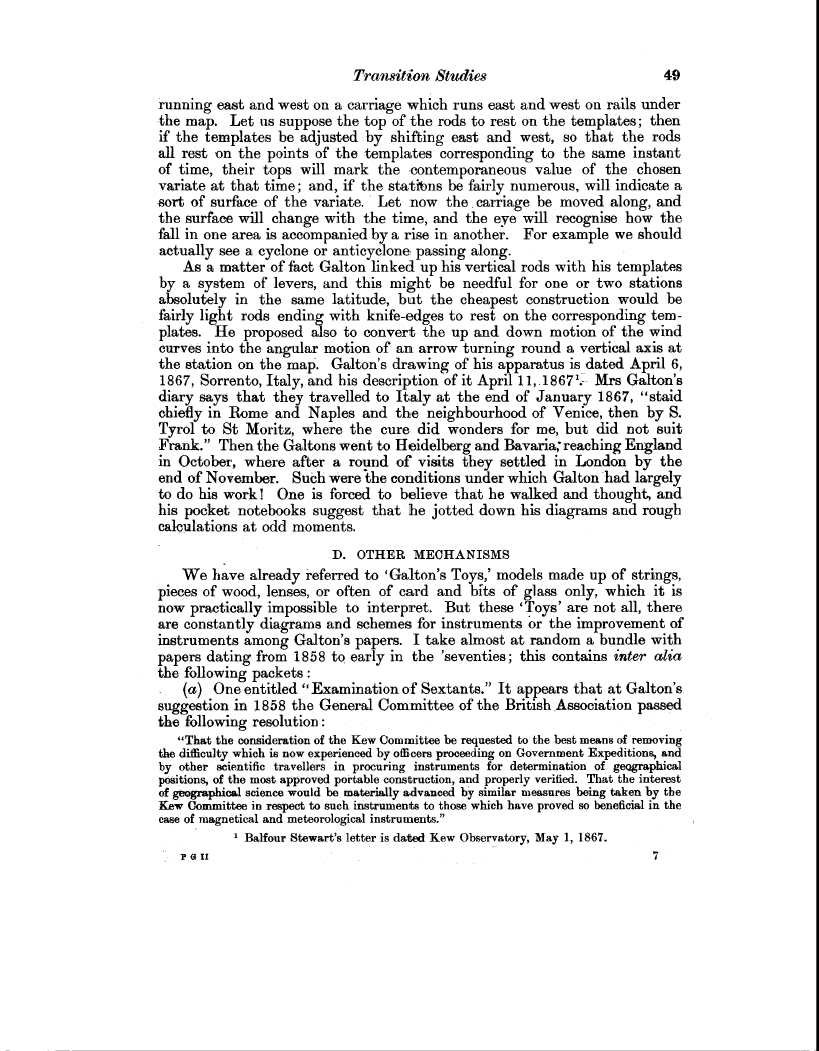Transition Studies 49
running east and west on a carriage which runs east and west on rails under -the map. Let us suppose the top of the rods to rest on the templates; then if the templates be adjusted by shifting east and west, so that the rods all rest on the points of the templates corresponding to the same instant of time, their tops will mark the contemporaneous value of the chosen variate at that time; and, if the stations be fairly numerous, will indicate a sort of surface of the variate. ' Let now the. carriage be moved along, and the surface will change with the time, and the eye will recognise how the fall in one area is accompanied by a rise in another. For example we should actually see a cyclone or anticyclone passing along.
As a matter of fact Galton linked up his vertical rods with his templates by a system of levers, and this might be needful for one or two stations absolutely in the same latitude, but the cheapest construction would be fairly light rods ending with knife-edges to rest on the corresponding templates. He proposed also to convert the up and down motion of the wind curves into the angular motion of an arrow turning round a vertical axis at the station on the map. Galton's drawing of his apparatus is dated April 6, 1867, Sorrento, Italy, and his description of it April 11,.18671:- Mrs Galton's diary says that they travelled to Italy at the end of January 1867, "staid chiefly in Rome and Naples and the neighbourhood of Venice, then by S. Tyrol to St Moritz, where the cure did wonders for me, but did not suit Frank." Then the Galtons went to Heidelberg and Bavaria; reaching England in October, where after a round of visits they settled in London by the end of November. Such were the conditions under which Galton -had largely to do his work! One is forced to believe that he walked and thought, and his pocket notebooks suggest that he jotted down his diagrams and rough calculations at odd moments.
D. OTHER MECHANISMS
We have already referred to 'Galton's Toys,' models made up of strings, pieces of wood, lenses, or often of card and bits of glass only, which it is now practically impossible to interpret. But these `Toys' are not all, there are constantly diagrams and schemes for instruments or the improvement of instruments among Galton's papers. I take almost at random a bundle with papers dating from 1858 to early in the 'seventies ; this contains inter alia the following packets
(a) One entitled "Examination of Sextants." It appears that at Galton's suggestion in 1858 the General Committee of the British Association passed the following resolution
"That the consideration of the Kew Committee be requested to the best means of removing the difficulty which is now experienced by officers proceeding on Government Expeditions, and by other scientific travellers in procuring instruments for determination of geographical positions, of the most approved portable construction, and properly verified. That the interest
of geographical science would be materially advanced by similar measures being taken by the Kew Committee in respect to such instruments to those which have proved so beneficial in the case of magnetical and meteorological instruments."
1 Balfour Stewart's letter is dated Kew Observatory, May 1, 1867.
?GII 7

